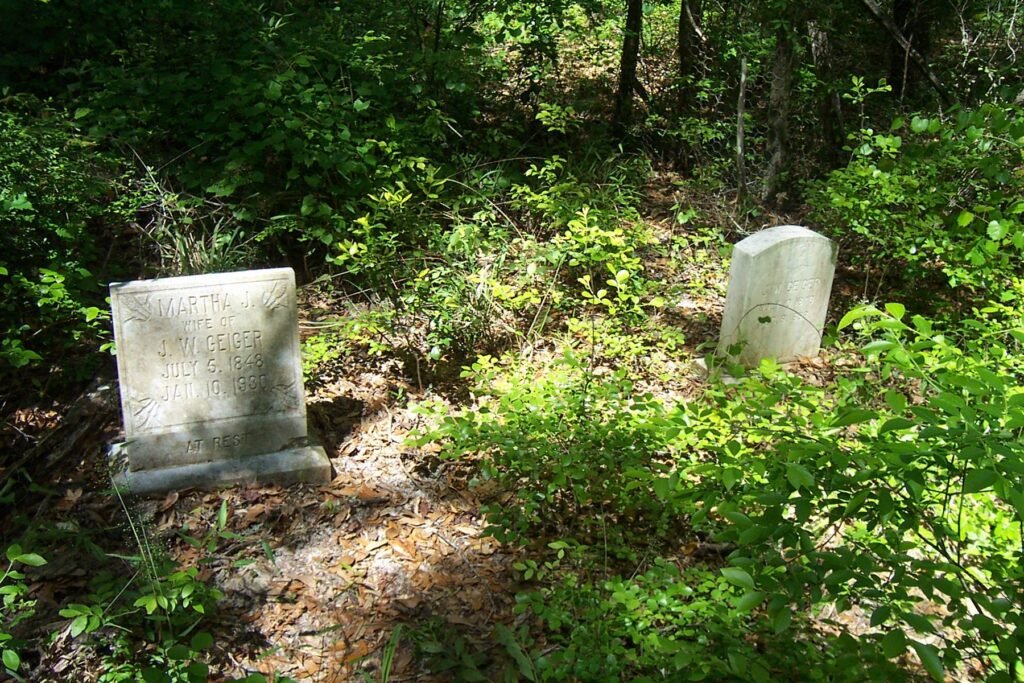If you walk through old cemeteries along the Georgia and Florida coasts, you’ll often find rows of marble and granite headstones dating back to the early 1800s. Weathered, yes, but still standing, carved with care and sentiment. Yet, head inland into the Wiregrass region of Florida and Georgia, and the story changes. In cemeteries, marked graves from the 1820s through the 1870s are few and far between. Instead, you might see only a sunken patch of earth, a pile of bricks or fieldstones, or no visible sign of a grave at all.
So why the difference?
It has everything to do with transportation. In the early 1800s, marble and granite could be shipped easily by steamboat to Florida and Georgia’s coastal towns. Waterways like the Savannah, Altamaha, and St. Mary’s Rivers acted as natural highways, delivering stone from the Carolinas or even as far as Vermont. Once offloaded, the materials could be hauled a short distance to nearby cemeteries.
But inland Florida and Georgia, particularly the Wiregrass region, was a different story. This was frontier territory: pine forests, sandy soil, swamp land, and rough wagon trails. Settlers could manage daily supplies overland, but hauling a quarter-ton tombstone was a different matter. It was expensive, labor-intensive, and often simply not possible for pioneer families trying to carve out a life from scratch.
As a result, they used what was at hand. Wooden boards, local stones and bricks, or sometimes nothing at all. Over the years, wooden markers decayed and stones and bricks shifted or disappeared. What we’re left with are cemeteries that feel incomplete, though they once held just as much sorrow and remembrance as those along the coast.
It wasn’t a lack of care that led to unmarked graves. These families honored their dead, but without the means to mark resting places in etched stone, memory had to live on in family Bibles, and oral traditions. The stone simply couldn’t make the journey into the swamps and woods with them.
While researching the Bennett pioneer families of Wiregrass Georgia, I came across one of these old cemeteries. It belongs to what is now called Manor Community Baptist Church. In the 1800s, it was known as Camp Branch Primitive Baptist Church. If you were to drive from Waycross to Homerville on Hwy 84 just past the Red Barn, a small farmer’s market, you would hang a right on Jim Mixon Road and travel until you see the church and cemetery on your right. Located at the corner of Jim Mixon Road and Camp Branch Road in Axson, Georgia, this cemetery is the largest and oldest in the community of Manor. Unfortunately, it lacks many markers for the early pioneers buried there.
Among those hardy pioneers were Asa and Fannie (Harris) Bennett Geiger. Asa, born around 1799 in Bryan County, Georgia, was the son of Abraham and Mary Geiger and the grandson of German immigrants Hans Ulrich and Apollonia (Seckinger) Kegar. Asa married Fannie (Harris) Bennett as his second wife. She had previously been married to John Bennett of Lowndes County, Georgia.
Another descendant of Hans Ulrich was James William Geiger, Jr., a Civil War veteran and son of James William Geiger, Sr. and Martha Harris. Both James Sr. and James Jr. died in Nassau County, Florida. However, only the graves of James Jr. and his wife, Martha Christopher Johnson, are marked. Their headstones still stand in the small Geiger Family Cemetery off Joshua’s Way Retreat Acres Road in Hilliard. Many of James William Geiger’s descendants still live in Nassau County today. We don’t know where James Sr. is buried. He was alive in the 1870 census residing with his family just a few houses down from his son, James Jr., about 8 miles west of Hilliard on the St. Mary’s River.


A different story plays out with another Bennett couple, John and Sallie (Register) Bennett. Their graves now feature a marker that wasn’t added until 1968, a full century after John and Sallie’s death. The family had always known where they were buried, but the headstone wasn’t placed until a Register family reunion was held at Wayfare Primitive Baptist Church in Statenville, Georgia. Wayfare was organized in May 1841. While the exact date is not recorded in its own archives, it is mentioned in the minutes of Union Church. Early records were not kept until around 1847 or 1848, but have been preserved since then. The founding members all came from Union Church in Lakeland, Georgia. Located on the south side of Cow Creek, a tributary of the Alapaha River, the Wayfare church was originally part of Lowndes County. It was transferred to Clinch County in 1850 and then to Echols County in 1858. The cemetery is extensive and notable for having a high percentage of marked graves. But you can see why. Later descendants added gravestones well after the deceased had passed. I have found that Huxford himself is partly responsible for this phenomenom, as he eloquently says in volume 2, page 115, beaneath the sketch of David Geiger, 1795-1870.
Ninety per-cent of the readers of this book, are descendants of the old pioneers in these volumes. It will be observed that very few of the graves of these old pioneers have ever been marked, nothwithstanding their location is frequently known. Descendants who are readers of this book, should make an effort to see that these graves are marked. The present generation is probably the last that will ever go to the trouble and expense of marking these graves.
While a new stone is a touching tribute, genealogists must be cautious when evaluating the information found on it. On the Bennett marker, the information was added more than 100 years after their deaths. Who provided the details? Were they accurate? With so much time passed, it’s impossible to know for sure.
These two seemingly unrelated John Bennetts lived in the same area of Georgia, during the same time period. Their overlapping timelines and similar names illustrate the challenge of researching this era in Wiregrass Georgia. These were hardy pioneers who moved their families into a vast and mostly unrecorded wilderness. Infrastructure, both governmental and religious, was slow to reach them. In many cases, the only surviving record is a family Bible entry or the memory of an elder relative.
A walk through their graveyards reminds us that even those things written in stone, may not be true, but it may also be, all we have left.
At this point, I’ve completed fifteen family sketches for the Pioneers of Wiregrass Georgia. I’m correcting errors in the original manuscript and documenting the lives of these families as accurately as possible. With an estimated 10,000 sketches in the full work, it’s no surprise that many contain inaccuracies. Relying on family memory for details long passed is one of the least accurate methods of research we have. Still, Folks Huxford, the original compiler, did what he could. While he consulted churches, counties, state archives, and national records, he often had to lean on interviews with elder descendants and judge their stories against the few written records available.

Dennis, Thank you for this excellent article. I review applications for the Florida Pioneer Program, a project of the Florida State Genealogical Society, and am forwarding it to our committee members. It will be helpful both to reviewers and to applicants.